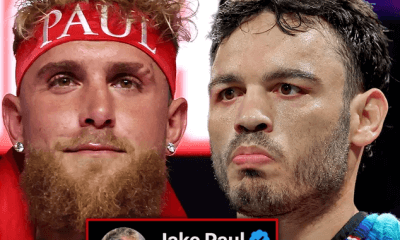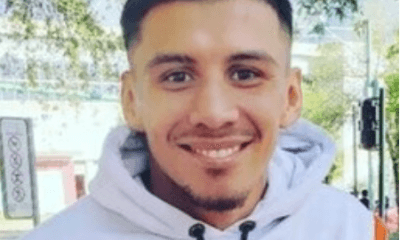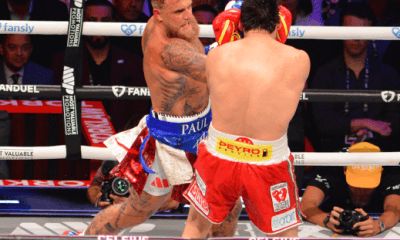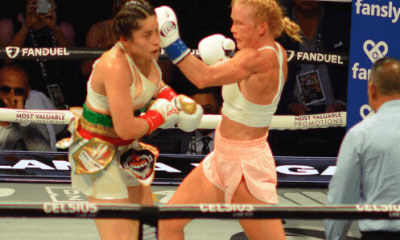Featured Articles
Rob Brant is the New WBA Middleweight Champion

LAS VEGAS, Nevada- In a major upset that saw a mega fight disappear, Rob Brant took the WBA middleweight title from Japan’s Ryota Murata with a lot of hustle and a heck of a chin to the surprise of many on Saturday.
Murata (14-2,11KOs) was expected to fight Gennady “GGG” Golovkin if he won, but the dress rehearsal turned into a nightmare as Brant (24-1, 16 KOs) attacked and attacked while out-punching the Japanese fighter nearly two to one in front of a stunned audience of more than 2700 at the Park Theater at the MGM.
“This was one of the best moments of my life, said Brant. “I wasn’t thinking of punch output. I was thinking about winning.”
With many planning their trips to Tokyo for an expected showdown between Murata and Golovkin, the Las Vegas based Brant put a stick into the spokes of their travel plans.
Brant started quickly with combination punching and moving in and out of range during the first three rounds of the middleweight bout. Murata smiled throughout the incoming blows from the upstart Brant.
“It’s easy to smile, but his eyes were swollen and he had blood on his mouthpiece,” said Brant.
It wasn’t until the fourth round that Murata found life while attacking the body.
The body punches opened up the lead right cross for Murata, who began targeting Brant’s head. But the Minnesota native was able to absorb the big blows and kept firing back. Though Brant was landing more shots, Murata’s punches were clearly harder and landed with a thud.
The crowd got into the fight early as cheers of “USA! USA!” were shouted sporadically throughout the fight. It probably had an effect on the judges.
It seemed Murata was landing the more effective blows in the middle rounds, especially when he targeted the body, then switched to the head. But though they were hard punches, Brant moved backward and kept returning fire.
The action was measured, but constant, with no slow rounds after round three. At times it looked like Murata was about to score a knockout but it never came. Brant proved resilient. More than that, he convinced the three judges he was the winner 119-109(2x) and 118-110.
Only the widespread scores were surprising. It seemed like a much closer fight.
Dudashev prevails
Maxim Dudashev (12-0, 10 KOs) tried to blast it out with Mexico’s Antonio DeMarco (33-7-1, 24 KOs), but after taking heavy incoming fire, the undefeated super lightweight changed tactics and out-boxed the former world champion to win by unanimous decision.
Dudashev moved around just enough and used quick short combinations to out-score the long-armed Tijuana fighter after the midway point of the 10-round affair. Though DeMarco was able to score with heavy body shots and lead lefts to the head, Dudashev managed to fire off combinations that kept winning rounds in the second half of the fight. The judges scored the fight 97-93, 96-94, 98-92 for Dudashev. TheSweetScience.com scored it 96-94 for Dudashev, who keeps the NABF super lightweight title.
“This was a great learning experience for me,” said Dudashev. “DeMarco is a true champion, and he fought with great heart and determination.”
Falcao and other bouts
Brazil’s Esquiva Falcao (22-0, 15 KOs) showcased his various boxing skills against Argentina’s Guido Pitto (25-6-2, 8 KOs) who lost by unanimous decision but forced the undefeated fighter into various situations. In the first four rounds, Falcao fought from the outside with impunity as Pitto was unable to touch the Brazilian. But when the Argentine boxer took the fight inside, he found more success and forced Falcao to utilize his inside boxing skills. The fighting was intense but Falcao was just too strong and slightly quicker in winning every round in the 10 round middleweight fight. Pitto’s best moments came during the fifth round when he forced his way inside. All three judges saw it 100-90 for Falcao.
Ireland’s Michael Conlan (9-0, 6 KOs) battered Nicola Cipolletta (14-7-2) every round with rights to the body and head. The Italian boxer rarely fired back and after several unanswered blows by Cipolletta the referee Russell Mora stopped the featherweight fight @1:55 of round seven. Cipolletta protested the stoppage but never truly engaged Conlan, who must have connected on more than 60 percent of his punches thrown. It was a whitewash for the former Irish Olympian.
Vladimir Nikitin (2-0) won by unanimous decision over Louisiana’s Clay Burns (5-5-2) in a featherweight fight that was much closer than the scores given. Burns started out fast and easily won the first two rounds. Then the battle got much closer as Nikitin’s overhand rights began scoring. Burns switched to southpaw and switched back and forth and that gave Nikitin pause. The last two rounds were very close especially the final round. But all three judges scored it 59-55 for Nikitin, thus only giving Burns one round. It was much closer in reality.
A battle between undefeated Puerto Rican lightweights saw Joseph Adorno (10-0, 9 KOs) drop Kevin Cruz (8-1, 5 KOs) twice in winning by unanimous decision. Though Adorno’s knockout streak was snapped, he engaged in a spirited battle against left-handed Cruz who let loose in the sixth and final round. A counter left hook by Adorno floored Cruz the second time during a furious exchange. Cruz beat the count and tried his best to go for the knockout; Adorno scooted away until the final bell. Scores of 59-53(2x) and 58-54 for Adorno.
Adam Lopez (11-1, 5 KOs) won by knockout over Hector Ambriz (12-8-2) in a featherweight match. The end came @1:29 of the eighth and final round of the fight when Lopez fired a four punch combination that forced referee Tony Weeks to halt the fight though Ambriz was still standing.
Uzbekistan’s Fazliddin Gaibnazarov (6-0, 3 KOs) stopped veteran Wilberth Lopez (23-10, 15 KOs) with a series of body blows @2:13 of round two in a super lightweight contest between lefties.
Check out more boxing news on video at The Boxing Channel
-

 Featured Articles3 weeks ago
Featured Articles3 weeks agoAvila Perspective, Chap. 330: Matchroom in New York plus the Latest on Canelo-Crawford
-

 Featured Articles2 weeks ago
Featured Articles2 weeks agoVito Mielnicki Jr Whitewashes Kamil Gardzielik Before the Home Folks in Newark
-

 Featured Articles4 weeks ago
Featured Articles4 weeks agoOpetaia and Nakatani Crush Overmatched Foes, Capping Off a Wild Boxing Weekend
-

 Featured Articles3 weeks ago
Featured Articles3 weeks agoCatching Up with Clay Moyle Who Talks About His Massive Collection of Boxing Books
-

 Featured Articles4 weeks ago
Featured Articles4 weeks agoFabio Wardley Comes from Behind to KO Justis Huni
-

 Featured Articles2 weeks ago
Featured Articles2 weeks agoMore Medals for Hawaii’s Patricio Family at the USA Boxing Summer Festival
-

 Featured Articles3 weeks ago
Featured Articles3 weeks agoThe Shafting of Blair “The Flair” Cobbs, a Familiar Thread in the Cruelest Sport
-

 Featured Articles3 weeks ago
Featured Articles3 weeks agoRichardson Hitchins Batters and Stops George Kambosos at Madison Square Garden





















